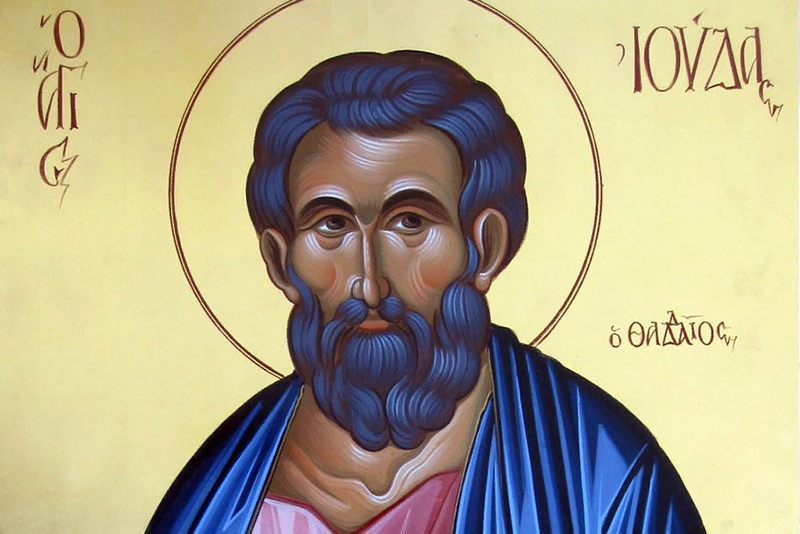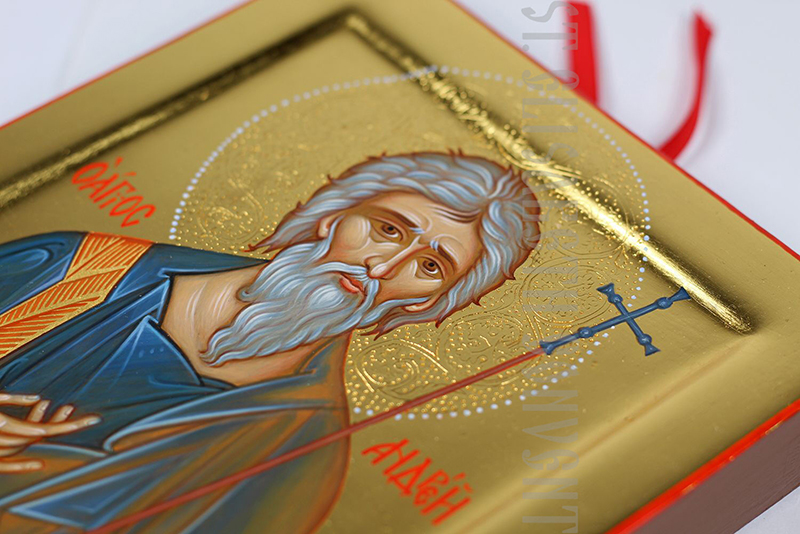
Matthias (Greek Ματθίας, Hebrew מַתִּתְיָהוּ – “gift of Yahweh”) is one of the disciples of Jesus Christ, who, according to the book of Acts, has drawn the lot of the apostolic ministry and was numbered in the Synaxis of the 12 Apostles, taking the place of the apostate Judas Iscariot. Having, according to St Paul, Christ Himself as the cornerstone, the church is premised on the foundation of the prophets and apostles. Mathias is one of these church pillars, which, unfortunately, we are little acquainted with. Below are the basic facts about the 12th Apostle known to us from the Holy Scripture and church tradition.
Evidence of the New Testament
Neither the synoptic Gospels (Matthew, Mark and Luke) nor the Gospel of John make any mention of St Matthias. However, according to the words of St Peter the Apostle, quoted in the book of Acts (Acts 1: 15-26), we can learn that Matthias may have been one of the 70 apostles, because he accompanied Jesus since his baptism by St John and witnessed the Resurrection of Christ. According to Cephas, the need to restore the sacred number of the 12 apostles originates from their messianic community being the New Israel and representing the 12 Israelite tribes. The proposal of Simon Peter was approved by the rest of the disciples, after which Joseph Barsabbas (also known as Justus) and Matthias (not to be confused with the Evangelist Matthew) appeared before them. Because the apostles had not yet been enlightened by the Holy Spirit, they did not dare to elect their new brother. Instead they decided to cast lots, directing their prayer to the Heart-bearer of all, so that He Himself would point to His chosen one. The lot fell on Matthias, so he was numbered among the Twelve. We do not see any other mention of Matthias in the Scriptures of the New Testament, but it is obvious that he was with all the disciples on the day of Pentecost.
Testimony of the Church Tradition
All further information about the life and ministry of the Apostle Matthias is rather vague and contradictory. Eastern tradition claims that Saint Matthias was planting the seed of faith in the Roman province of Cappadocia, as well as in the Caspian Sea region, departing on his missionary travels from a seaport town of Issus. According to Nikephoros Kallistos Xanthopoulos (one of the last great Byzantine historians, died around 1350), Matthias first preached in Judea (Ecclesiastical History, II, 40), and then he has drawn the lot to preach the gospel in Colchis (present-day Abkhazia, Georgia), where he was crucified. The Coptic apocryphal Acts of the Apostles Andrew and Matthias assign the ministry of the twelfth apostle to the “city of cannibals” in Ethiopia. Oddly enough, instead of the African country south of Egypt, in the apocryphal acts the geographic name Ethiopia refers to a region in the Caucasus (the so-called Pontic Ethiopia), where the ancient Egyptians had a military colony on the Alazani River. Later, the Romans built their vanguard in that place (the Gonio Apsaros fortress in the region of Adjara, modern Georgia), where, according to local legend, the relics of the apostle rest.
The so-called Synopsis of Dorotheus of Tyre contains a similar tradition, according to which “Matthias preached the Gospel to barbarians and meat-eaters in the interior of Ethiopia (Georgia), where the sea harbor of Hyssus is, at the mouth of the river Phasis. He died at Sebastopolis, and was buried there, near the Temple of the Sun.” Finally, the third version of the life of St Matthias (The Menaion Reader of St. Demetrius of Rostov) asserts that he was condemned by the synedrion and stoned (the Greek Menaea mention crucifixion), and then beheaded in Jerusalem, hence the popular Western iconographic depiction the Apostle Matthias with a halberd or if an axe. St Hippolytus of Rome is the only one whose version clearly stands apart, claiming that Matthias died of old age in Jerusalem. The death of the apostle is attributed to the 60s or 80s of the 1st century.
Gospel of Matthias?
Origen (Hom. In Lucam) speaks of the existence of the “Gospel of Matthias”, which is also mentioned by Eusebius of Caesarea (Church History, III, 25), reckoning it among the heretical books. Blessed Hieronymus of Stridon and the famous 6th century Pope Gelasius’s decree both classify it as apocryphal. It is quite possible that Matthias really has written his own Gospel. However, it could also have been a so-called pseudo-epigraph, i. e. a Gospel or a collection of legends, signed with the name of the 12th Apostle. That text was often referred to by various heretics and Gnostics, as evidenced by Clement of Alexandria in his writings. Describing the early Christian sect of the Nicolaitans, Clement cites one such quote, attributed to the apostle Matthias: “We must combat our flesh, set no value upon it, and concede to it nothing that can flatter it, but rather increase the growth of our soul by faith and knowledge” (Stromata, III, 4). Replete with excessive asceticism and rejection of the body, this text was often used by Gnostics, which may be one reason why the Church Fathers did not include it in the biblical canon.
The memory of St Matthias is celebrated on August 9 and June 30 (the Synaxis of the 12 Apostles). A part of his relics is believed to rest in the Benedictine Abbey of St Matthias in Trier (Germany), where it was brought by St Helena. The apostle’s relics are also kept in the Abbey of Santa Giustina in Padua (Italy), as well as in the Gonio Apsaros fortress (Gonio, Georgia).
Holy Apostle Matthias, pray to God for us!




